Dealing with a knee injury can feel frustrating, especially when you're eager to get back to your workout routine. Whether it’s from sports or daily strain, knee pain is more common than ever. Girls’ volleyball injuries have jumped 96%, and boys' lacrosse injuries are up 61%. But jumping back in too fast can make things worse. In this guide, you'll learn how to safely rebuild knee health, protect your injured knee, and work toward a stronger knee joint with help from a physical therapist and smart movement strategies.
Key Takeaways
-
Consult healthcare professionals for personalized recovery plans and gradual exercise progression to prevent further injury.
-
Incorporate gentle exercises, physical therapy, and flexibility training to enhance knee strength, mobility, and overall health.
-
Commit to a long-term maintenance routine that includes low-impact cardio, regular strengthening, and proper warm-up practices to support ongoing knee health.
Consult Your Doctor or Physiotherapist for a Personalized Recovery Plan
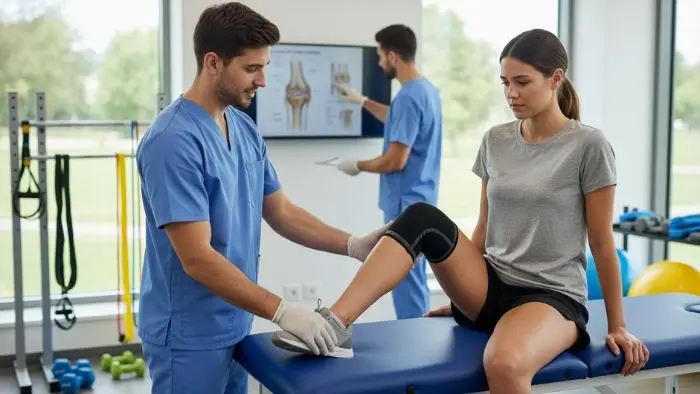
Before doing anything else, the first and most important step after a knee injury is to consult your doctor or physical therapist. A proper medical evaluation helps you understand exactly what is happening with your knee joint, whether it involves a ligament tear, a cartilage issue, or general instability. This step is essential for creating a recovery plan that protects your progress and avoids setbacks.
Jumping into a workout routine too early or without guidance increases the risk of further injury. Research shows that fewer than 50% of athletes return to their previous performance levels after ACL surgery. Even more concerning, those who return to activity within two years of reconstruction are up to six times more likely to suffer another injury. Nearly 30% experience a new injury within 24 months, often on the opposite leg.
Working with a physical therapist is one of the best ways to reduce these risks. Specialists in sports injuries, they help you gradually restore strength and improve range of motion in your injured knee. Guided physical therapy allows you to move forward with confidence while protecting your knee health.
Consistent medical support keeps your recovery on track. Your care team will adjust your plan as you heal, making sure you avoid complications and stay focused on long-term results. Recovery is not just about healing, it is about preventing future injury and rebuilding strength the right way.
Start Slow with Gentle Knee Exercises
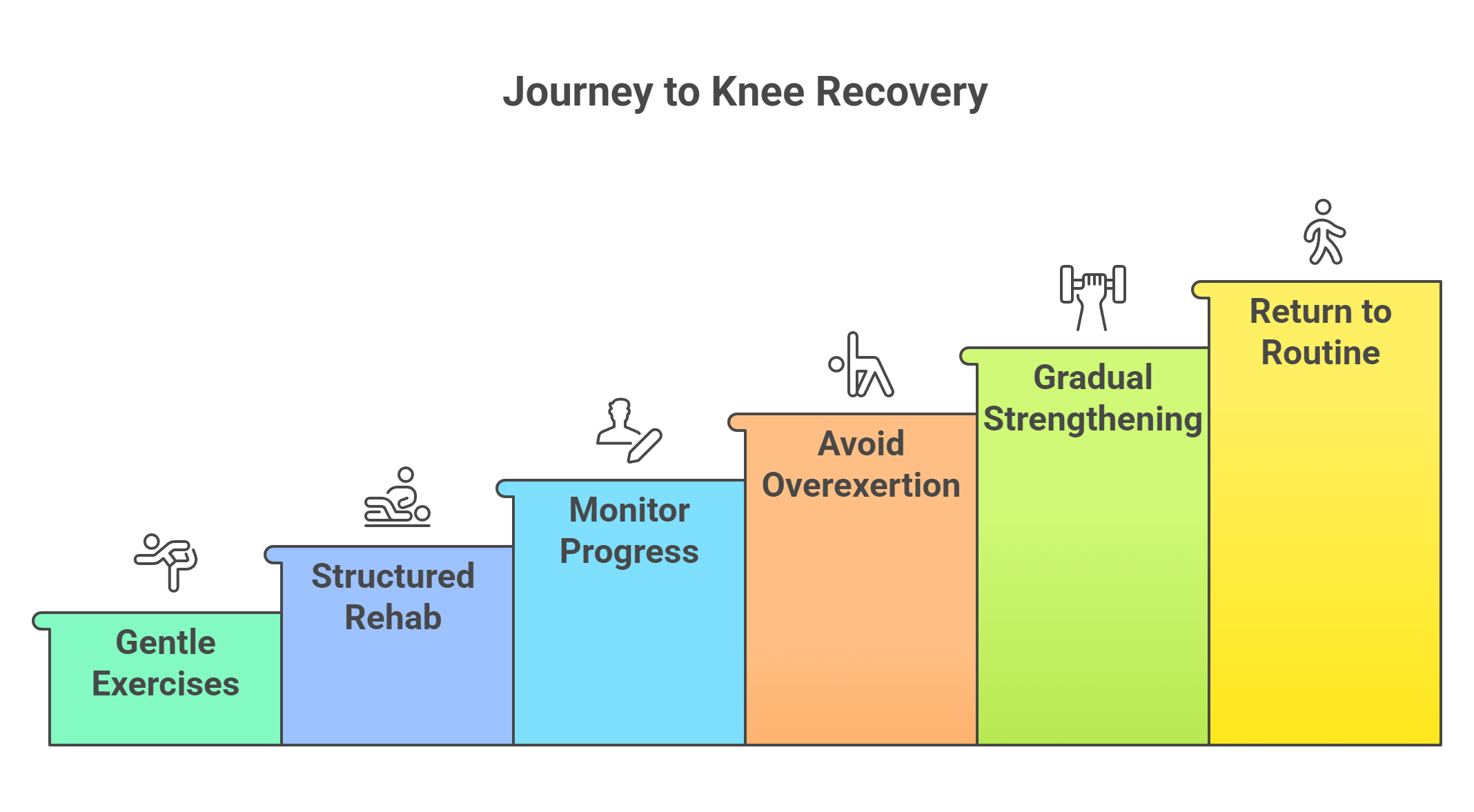
Once your doctor or physical therapist gives you the green light, the next step in how to start working out again after knee injury is to start slow with gentle movement that supports healing in your injured knee. Early exercise should focus on light, pain free movements that improve your range of motion and strengthen the knee joint without causing strain or further injury.
According to the Journal of Orthopaedic & Sports Physical Therapy, over 200,000 ACL injuries occur each year in the United States, leading to nearly 100,000 reconstruction surgeries. While surgery is often necessary, it is not the only factor in recovery. Studies show that outcomes improve significantly when patients follow a structured, scientifically designed rehabilitation plan. Supervised physical therapy has been shown to result in greater joint motion, improved muscle strength, and faster functional recovery compared to unsupervised recovery methods.
Start with simple movements tailored to your injured area and current ability. These might include light stretching or movements designed to gently bend and extend the leg. You may be guided toward exercises like quad sets, heel slides, or straight leg raises depending on your progress. Your physical therapist will customize a plan that helps you gradually build strength and improve your balance while avoiding pressure on the joint.
To make consistent progress:
-
Keep a recovery journal. Tracking your daily activities, pain levels, and exercises helps you stay motivated and monitor your symptoms.
-
Pay close attention to discomfort, fatigue, or swelling. If you feel pain, stop the activity and consult your provider.
-
Do not push through sharp or sudden pain. Always stop immediately if something feels wrong.
-
Modify your workout routine as needed to match your body's current limits and goals.
Supervised physical therapy not only helps improve range of motion, but also reduces long-term complications and risk of re-injury. Ignoring pain or doing too much too soon may lead to serious knee problems that require more extensive surgery or long-term care.
Gentle movement also improves circulation, encourages healing, and helps you safely return to your regular routine. Whether your injury happened from sports injuries, overuse, or trauma, this phase is about laying the groundwork—not adding more weight or high intensity just yet.
Stay consistent. Trust the process. And remember that real progress comes from focusing on the basics, protecting the knee, and working closely with your orthopedic surgeon or therapist to guide every step.
Importance of Physical Therapy
Physical therapy plays a vital role in recovering from a knee injury, whether you've undergone surgery or are following a non-operative plan. A physical therapist provides expert supervision, helping you recover safely while avoiding further injury. Tailored therapy supports healing by improving range of motion, reducing swelling, and restoring strength to the injured knee.
According to the National Institutes of Health, non-operative ACL treatment includes around 12 weeks of supervised physical therapy. The program begins with regaining full range of motion and progresses to strengthening the quadriceps, hamstrings, hip abductors, and core muscles. This structured approach leads to better joint stability, muscle control, and long-term outcomes. Patients following supervised rehab plans see significantly fewer setbacks and are more likely to safely return to sports or daily activities.
Beyond early recovery, physical therapy supports lasting knee health. It enhances joint function, restores mobility, and prevents chronic knee pain and other complications. Regular sessions can also help manage symptoms, such as stiffness or instability, while promoting better balance and posture.
Every therapy plan is tailored to your specific needs, whether you're recovering from surgery or managing a partial tear. With expert guidance, you will gradually progress, improve your strength, and regain control over your workout routine.
Skipping therapy or trying to recover without support increases the risk of re-injury, long-term dysfunction, and delayed healing. Working with a licensed physical therapist ensures that each phase of recovery is handled correctly.
Gradually Progress to Strengthening Exercises
Once your injured knee starts improving and you've finished a round or two of physical therapy, it’s a good time to gradually progress into strength training. This helps support your knee joint, improves stability, and gets your body ready for more active movement.
Building strength around the injured area is one of the best ways to protect yourself from further injury. Movements like hamstring curls, straight leg raises, heel slides, and step ups help restore your range of motion while activating the right muscles for control and support.
Research backs this up. A study in the Journal of Science and Medicine in Sport showed that after ACL surgery, patients still had up to 30 percent less quadriceps strength in the operated leg six months later. That kind of muscle loss can change how you move and increase the risk of more knee problems.
Here are a few tips to stay safe and make progress:
-
Keep your leg straight and movements controlled, especially when lifting or stepping
-
Use a stationary bike to gently increase endurance without stressing your knee
-
If you feel pain or notice swelling, stop immediately and check in with your physical therapist or orthopedic surgeon
-
Stick with your plan, track progress, and listen to your body
This part of recovery is all about slow, steady gains. With the right support, smart training, and a little patience, you’ll build strength, reduce discomfort, and safely return to the activities you enjoy.
Incorporate Flexibility Training for Better Results
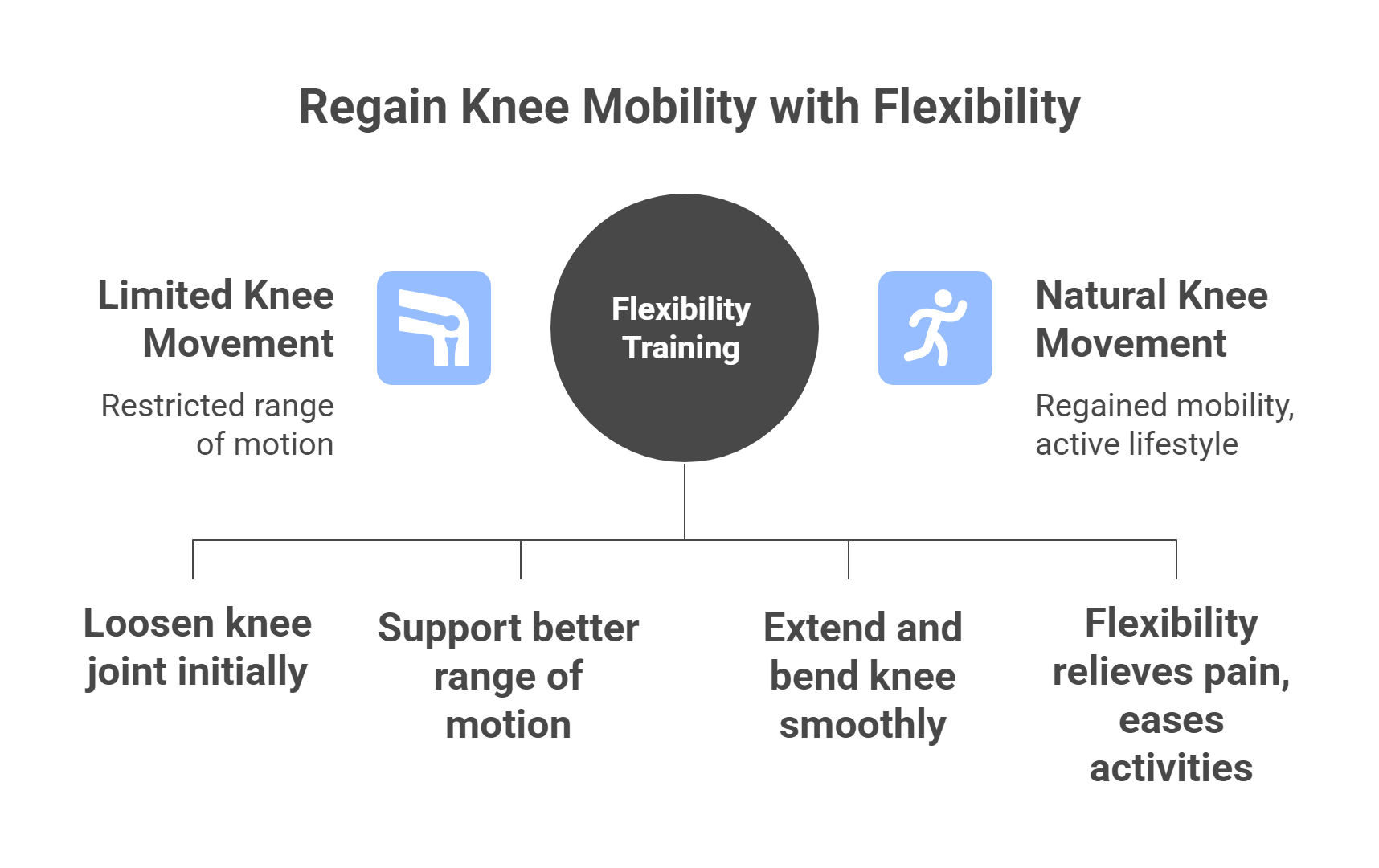
As your recovery progresses, flexibility training becomes an important step in helping your injured knee move naturally again. Gentle stretching supports your muscles, improves your range of motion, and helps prevent tightness that can limit movement or cause further injury.
A study by Shelbourne et al. (2022) followed more than 1,000 ACL patients and found that 95% regained normal knee extension just one week after surgery, while 77% restored normal flexion within three months. These results highlight how early flexibility work and consistent stretching can make a major difference in regaining mobility and overall knee health.
Incorporating stretching into your workout routine does not need to be complicated. Focus on light, controlled movements that help your leg extend and bend smoothly.
Try adding these habits to your daily routine:
-
Begin each session with light warm ups to loosen the knee joint and prepare your body
-
Perform standing quad and hamstring stretches to support better range of motion
-
Move slowly, keep your leg straight during stretches when possible, and stop if you feel pain
-
Stay consistent, and remember that flexibility training helps relieve pain and makes daily activities feel easier
Flexibility work also supports circulation, improves balance, and keeps surrounding muscles from becoming too tight. Over time, these small efforts help your knee regain its natural rhythm and movement so you can safely return to a more active lifestyle.
If you’re unsure where to begin, talk to your physical therapist or orthopedic surgeon.
How Low-Impact Cardio Helps Your Knees
Maintaining cardiovascular health is crucial during knee injury recovery. Low-impact cardio activities like swimming and cycling support knee recovery without excessive strain on the joint. Swimming, in particular, reduces pressure on the knees while providing a full-body workout.
Gradually increase the intensity of your cardio workouts as your recovery progresses. Consider the following to maintain an effective routine:
-
Engage in diverse low-impact activities to keep your routine interesting and help maintain motivation.
-
Use low-impact cardio to prepare your body for a return to more demanding sports and activities.
-
Ensure a well-rounded recovery by incorporating these strategies.
Adjusting Workouts When Your Knees Hurt
Monitoring pain is crucial for maintaining a safe workout routine. Recognizing pain indicators that require adjustments prevents further injury. Documenting pain levels, exercise performance, and recovery progress in a journal provides valuable insights into how your knee responds to different activities.
Make immediate adjustments to your workouts if you feel pain. Address persistent discomfort with professional input to relieve pain and receive appropriate guidance to avoid exacerbating your injury. Feedback from healthcare providers allows for ongoing adjustments tailored to your recovery needs.
An adaptable and aware mindset is key for successful rehabilitation and focus, as most people recognize, for example.
Protect Your Knees: Knee Braces and Gear That Work
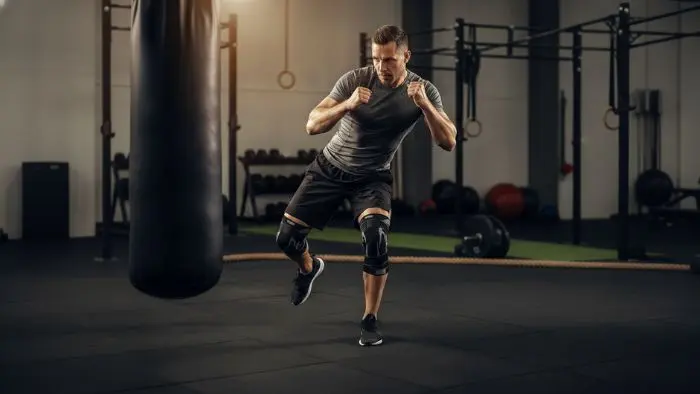
Protective gear, especially knee braces, can make a big difference as you ease back into your workout routine. They’re designed to support your knee joint, reduce unnecessary strain, and give you the confidence to move without fear of re-aggravating your injured knee.
The right brace doesn’t just offer stability, it helps you stay focused during training by keeping everything secure and aligned. A good fit is key, so always consult with your orthopedic surgeon or physical therapist to find one that suits your needs and recovery stage.
Whether you're recovering from sports injuries, dealing with post-surgical swelling, or just looking to prevent further injury, knee braces can support your return to activity without holding you back.
The Anaconda Knee Brace is trusted by over 150,000 athletes for a reason:
-
Compression helps relieve pain and support circulation during training
-
Stabilizing straps give support without limiting mobility
-
Gel padding absorbs impact during takedowns, rolls, or awkward landings
-
Anti-slip tech means it stays in place, no distractions mid-session
-
Quick to slip on and off, and comes in a range of sizes for the perfect fit
Whether you’re just returning to movement or want to protect a knee that’s taken some hits, the Anaconda brace gives you that extra layer of confidence.
Return to Sport-Specific Movements
Once your knee is stronger and your range of motion improves, you can start exercising with drills that mimic your sport. This is where you bring back the moves that matter most — running, pivoting, or agility work, but with control and purpose.
Make sure you're pain free and not compensating with the opposite leg before adding more weight or dynamic movement. If you feel pain, stop immediately, scale it back, and let your doctor or physical therapist recheck your readiness.
Focus on balance, coordination, and proper form. Even something simple like practicing walking, changing direction, or holding balance under pressure can help you safely return to full performance.
If you need extra stability, go ahead and use a supportive brace during training sessions. It’s a smart move, especially when working on higher-impact drills.
Consistent Use of Proper Warm-Ups
Before every session, start slow with dynamic warm ups to prepare your body, improve joint mobility, and reduce the risk of injury. A good warm-up boosts circulation, raises muscle temperature, and gets your legs, hips, and thighs ready to move.
Skip the old-school long static stretches before activity. Instead, try short stretch flows like high knees, hip circles, and foot mobility drills. These help activate the right muscles without putting your joints under early strain.
Warming up properly doesn’t take long, just 5 to 10 minutes of focused movement. It sets the tone for safer, more effective sessions.
Long-Term Maintenance Routine
Keeping your knee strong means sticking with a sustainable workout routine long after the pain fades. Regular strength work, smart flexibility training, and mobility drills all help reduce the risk of re-injury and keep your body moving well.
Don’t overcomplicate it. Combine basic exercises like quad sets, step ups, and light resistance work with plenty of rest between sessions. Your recovery plan should include time to repeat key moves, track progress, and adjust when needed.
If you're returning after surgery, lingering swelling, or muscle loss, keep working on your quadriceps, hips, and core. These areas play a big role in knee control.
To stay active, avoid letting long breaks derail your momentum. Even on lighter weeks, fit in some walking, mobility drills, or bodyweight work.
And remember, maintaining knee health is a long game. You’re not just bouncing back — you’re building a routine that supports strength, flexibility, and confidence for life.
Need help along the way? The Anaconda Knee Brace offers targeted support and compression, perfect for anyone easing back into training or just looking for peace of mind on the mat.
Final Words
Recovering from a knee injury and getting back into your workout routine takes time, consistency, and smart support. With guidance from your doctor or physical therapist, starting slow, and progressing carefully through strengthening, stretching, and low-impact exercises, you can rebuild knee health the right way.
Support tools like braces, warm ups, and flexibility training aren’t just optional — they’re part of a smarter, safer approach to recovery.
At Anaconda Fightwear, we’re here to help you safely return to training with gear designed to protect and support your movement, every step of the way.
Ready to train smarter and protect your knees?
Frequently Asked Questions
Got questions about knee injury recovery, workouts, or using support gear? We’ve answered the most common ones to help you move forward with confidence.
Why is it important to consult an orthopedic surgeon before starting a workout?
Consulting an orthopedic surgeon is essential to safeguard your joints and prevent re-injury by evaluating your musculoskeletal health and uncovering any potential issues. Prioritizing this step ensures a safer and more effective workout regimen.
What type of exercises should one start with after a knee injury?
After a knee injury, it's essential to start with low-impact exercises like heel slides and quad sets that promote joint stability and muscle control. These exercises can help facilitate a safe recovery.
Can cycling be beneficial for knee recovery?
Cycling can significantly aid in knee recovery by enhancing joint mobility while minimizing stress on the joint. It's a low-impact exercise that promotes healing and strength.
How can you track your progress after a knee injury?
Tracking your progress after a knee injury can effectively be done by maintaining a workout journal that records daily pain levels, swelling, exercises performed, and your knee's response. This method will provide clear insights into your recovery journey.
What should you do if your knee feels sore for more than 24 hours after exercise?
If your knee remains sore for over 24 hours after exercise, it's crucial to reassess your exercise routine and consult a healthcare provider for a proper evaluation. Taking these steps will help ensure your knee health and prevent further injury.



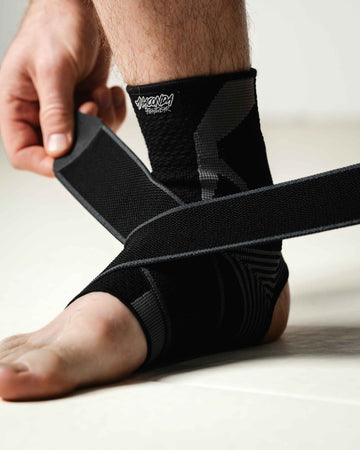



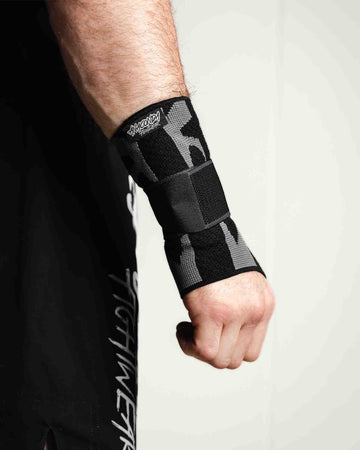

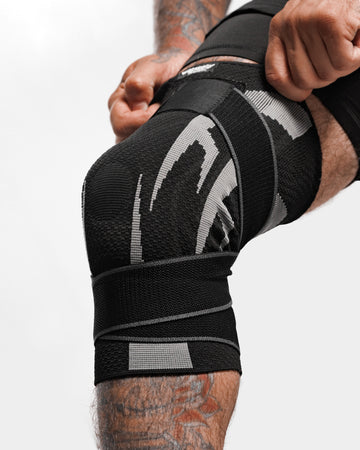



![How Long Does a Knee Injury Take to Heal? [Essential Insights and Tips]](http://anacondafightwear.co/cdn/shop/articles/How_Long_Does_a_Knee_Injury_Take_to_Heal.jpg?v=1764885786&width=533)
